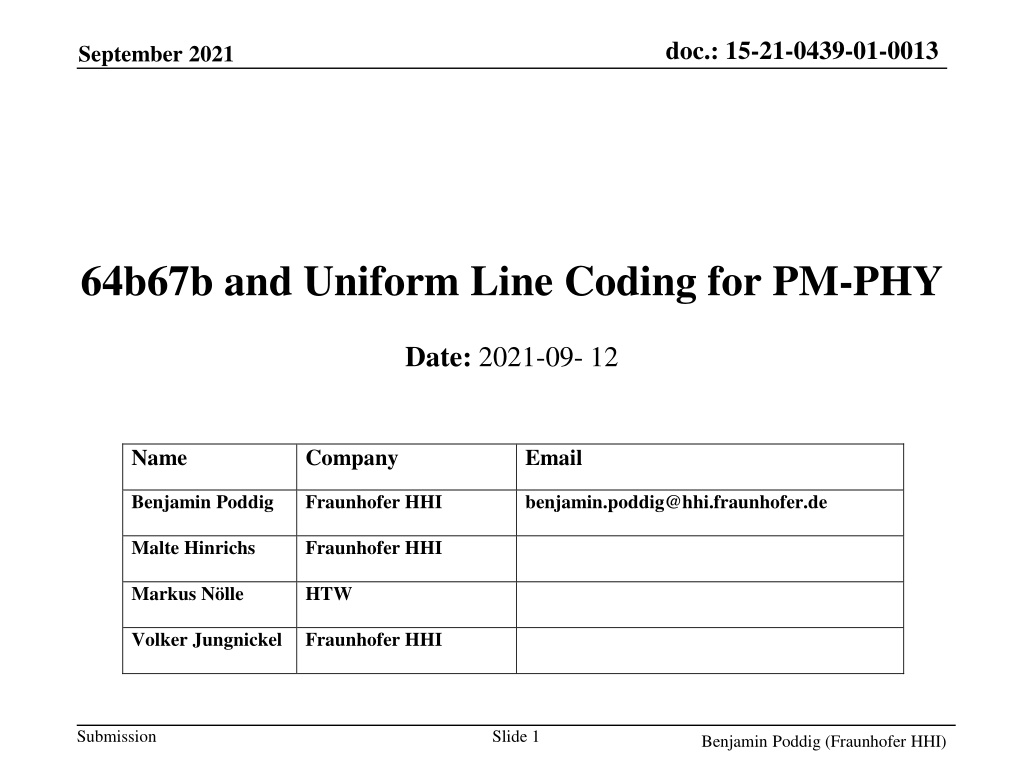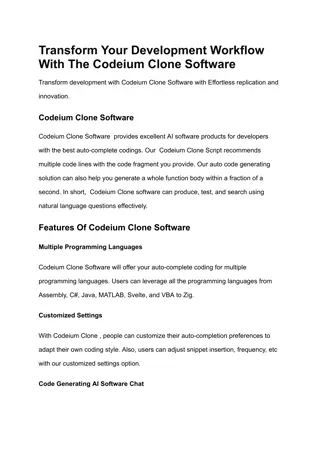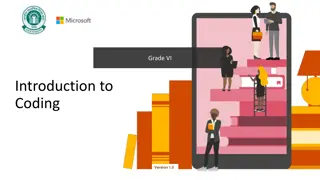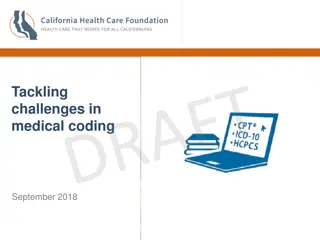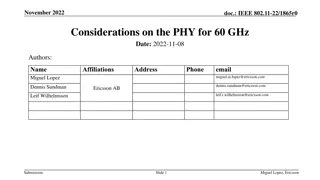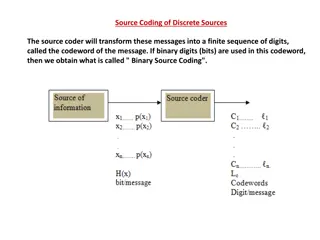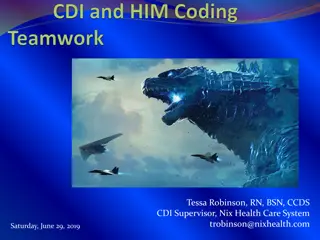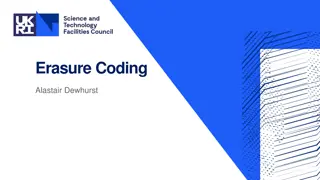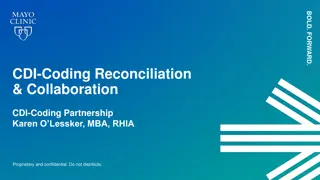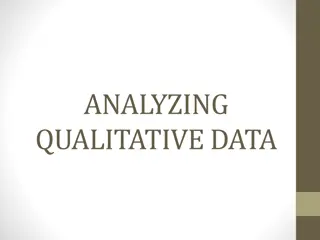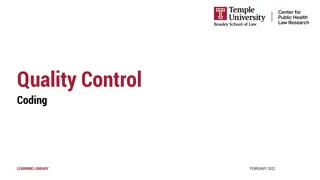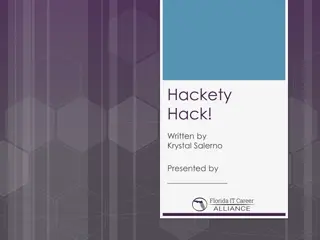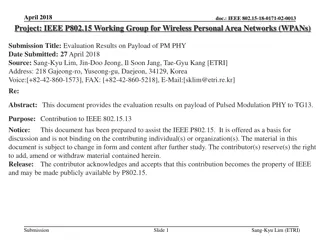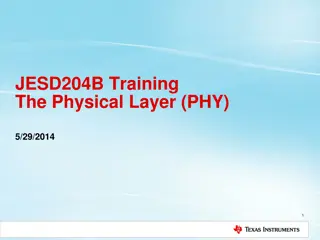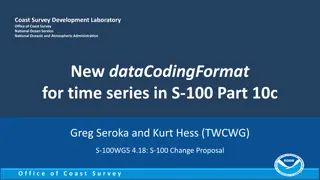Optimizing Line Coding for PM-PHY: A Detailed Analysis
Enabling line coding and channel equalization methods for PM-PHY, the IEEE 802.15.13 standard introduces overhead while enhancing channel adaptation. This contribution proposes 64b67b and Uniform Line Coding as alternative transmission modes, aiming to reduce line coding overhead while maintaining a good bit error rate performance. Different line coding schemes like 8b10b, 64b67b, and Uniform Line Coding are discussed, emphasizing the importance of DC balancing and optimizing run lengths for efficient data transmission. The trade-off between DC balancing and overhead is explored, shedding light on the significance of optimizing line coding for effective communication.
Download Presentation

Please find below an Image/Link to download the presentation.
The content on the website is provided AS IS for your information and personal use only. It may not be sold, licensed, or shared on other websites without obtaining consent from the author. Download presentation by click this link. If you encounter any issues during the download, it is possible that the publisher has removed the file from their server.
E N D
Presentation Transcript
doc.: 15-21-0439-01-0013 September 2021 64b67b and Uniform Line Coding for PM-PHY Date: 2021-09- 12 Name Company Email Benjamin Poddig Fraunhofer HHI benjamin.poddig@hhi.fraunhofer.de Malte Hinrichs Fraunhofer HHI Markus N lle HTW Volker Jungnickel Fraunhofer HHI Submission Slide 1 Benjamin Poddig (Fraunhofer HHI)
doc.: 15-21-0439-01-0013 September 2021 Abstract This contribution proposed 64b67b and Uniform Line Coding as alternative transmission modes for the PM- PHY. Submission Slide 2 Benjamin Poddig (Fraunhofer HHI)
doc.: 15-21-0439-01-0013 September 2021 Introduction IEEE 802.15.13 enables line coding and channel equalization methods for the PM PHY 8b10b FDE Both introduce overhead while improving channel adaption Efficient line coding schemes are proposed Line coding overhead can be reduced with an alternative line coding method maintaining a good BER performance trade off between overhead and channel adaption Submission Slide 3 Benjamin Poddig (Fraunhofer HHI)
doc.: 15-21-0439-01-0013 September 2021 Line Coding Why optimizing Line Coding? Goal: DC balancing Low disparity = Low DC imbalance within subsequent code words (Long duration) Low run lengths = Low DC imbalance within subsequent modulation symbols (Short duration) Tradeoff : DC balancing vs. Overhead Submission Slide 4 Benjamin Poddig (Fraunhofer HHI)
doc.: 15-21-0439-01-0013 September 2021 Line Coding Schemes 8b10b Guaranteed DC balancing and disparity balancing by predetermined code book with optimized run lengths 25% overhead 64b67b (Guided Scrambling) Statistical optimized DC balancing, disparity balancing and run lengths limiting by code word selection 4.7% overhead Uniform Line Coding (same as 64b66b but w/o the overhead) Statistical DC balancing by law of large numbers, (prior scrambling mandatory) 0 % overhead Submission Slide 5 Benjamin Poddig (Fraunhofer HHI)
doc.: 15-21-0439-01-0013 September 2021 Run Length after Line Coding Line codes can reduce run lengths uniformly distributed input sequences (=no line coding) are obtained by scrambling before line coding Submission Slide 6 Benjamin Poddig (Fraunhofer HHI)
doc.: 15-21-0439-01-0013 September 2021 Disparity after Line Coding 8b10b and 64b67b set boundaries for disparity Uniform (w/o Line Coding) is out of bounds (note y-axis scaling) Submission Slide 7 Benjamin Poddig (Fraunhofer HHI)
doc.: 15-21-0439-01-0013 September 2021 Spectrum after Line Coding Line coding reduces low-frequency components : more overhead less impairments due to baseline wander Submission Slide 8 Benjamin Poddig (Fraunhofer HHI)
doc.: 15-21-0439-01-0013 September 2021 Baseline Wander after Line Coding Calculation of baseline wander percentages Baseline wander percentage = 100% ????/?Stream ?Stream= Average data stream amplitude Eye Amplitude ?BLW= Average baseline wander amplitude Zero crossing amplitude Submission Slide 9 Benjamin Poddig (Fraunhofer HHI)
doc.: 15-21-0439-01-0013 September 2021 Baseline Wander vs. Symbol Rate Baseline wander decreases with increasing symbol rate Submission Slide 10 Benjamin Poddig (Fraunhofer HHI)
doc.: 15-21-0439-01-0013 September 2021 BER of 8b10b Bit error rates for 8b10b (25% overhead) (Post-FEC BER is greyed out) 8b10b can reduce baseline wander also w/o EQ at clock rates <= 50 MHz with EQ, the performance is much better Slide 11 Submission Benjamin Poddig (Fraunhofer HHI)
doc.: 15-21-0439-01-0013 September 2021 BER of 64b67b Bit error rates for 64b67b (~5% overhead) (Post-FEC BER is greyed out) 64b67b needs EQ but reduces overhead to 5% Needs ~ 2dB more SNR compared to 8b10b when using EQ Submission Slide 12 Benjamin Poddig (Fraunhofer HHI)
doc.: 15-21-0439-01-0013 September 2021 BER with Uniform Line Coding Bit error rates with Uniform Line Coding (0% overhead) (Post-FEC BER is greyed out) Uniform Line Coding needs EQ but reduces overhead to 0% Needs ~ 1dB more SNR compared to 64b67b with EQ Submission Slide 13 Benjamin Poddig (Fraunhofer HHI)
doc.: 15-21-0439-01-0013 September 2021 Conclusions FDE has major impact on BER It is not needed with 8B10B and 64b67b at lower symbol rates With FDE, the loss compared to 8B10B is 2 and 3dB SNR for 64B67B and Uniform Line Coding, respectively Overhead of 25, 4.7, 0% for 8b10b, 64b67b and Uniform Line Coding, respectively Proposal is to add new MCS to PM PHY which allow 64b67b Line Coding Uniform Line Coding New modes enable higher data rates for PM PHY At a reasonable price in terms of performance Submission Slide 14 Benjamin Poddig (Fraunhofer HHI)
doc.: 15-21-0439-01-0013 September 2021 To be specified 64b67b Line Coding scheme Uniform Line Coding scheme Integration into the PM-PHY Decoding approach Padding: Mapping of FEC code words onto the used Line Code Submission Slide 15 Benjamin Poddig (Fraunhofer HHI)
doc.: 15-21-0439-01-0013 September 2021 Guided Scrambling Line Coding Exemplary: 64b67b N = 64, Na= 3 General encoding process Augment (<=N)-bit data by Na-bit values Scramble data Select code word out of 2^Na quotients General decoding process Descramble (<=N+Na)-bit code block Remove augmentation bits from the beginning of the output sequence Submission Slide 16 Benjamin Poddig (Fraunhofer HHI)
doc.: 15-21-0439-01-0013 September 2021 Guided Scrambling Line Coding data Scramble 0 0 0 Encoding (N <= 64) data Scramble 0 0 1 (N <= 64) data Scramble 0 1 0 (N <= 64) data Scramble 0 1 1 (N <= 64) data code (N <= 64) 3 Augmentation Code Selection (N <= 64) data Scramble 1 0 0 (N <= 64) data Scramble 1 0 1 (N <= 64) data Scramble 1 1 0 (N <= 64) data Scramble 1 1 1 (N <= 64) quotients Submission Slide 17 Benjamin Poddig (Fraunhofer HHI)
doc.: 15-21-0439-01-0013 September 2021 Guided Scrambling Line Coding Decoding data code (N <= 64) data (N <= 64) 3 Descramble 3 Demux (N <= 64) Submission Slide 18 Benjamin Poddig (Fraunhofer HHI)
doc.: 15-21-0439-01-0013 September 2021 Scrambler configuration Data In Scrambling polynomial X^Na+X^0 Scrambler initialization Initialize each scrambler for every data block of length (<=N) at first bit Process for each data block Pre-ocuppy each scrambler with augmentation values aug := [CNa, , C2, C1] where CNais MSB of augmentation value Scramble (<=N)-bit data block Mux Na-bit augmentation value and scrambled block Data Out C1 C2 C3 aug Scrambler, Na=3 Submission Slide 19 Benjamin Poddig (Fraunhofer HHI)
doc.: 15-21-0439-01-0013 September 2021 Exemplary Code Selection method A) Specify a test vector for the first quotient for 64b67b guided scrambling LC for testing purposes Guided scrambler output = Q1 B) Specify a test vector for each of the eight quotients for 64b67b guided scrambling LC for testing purposes Guided scrambler output = Qi, i = (1 8) Submission Slide 20 Benjamin Poddig (Fraunhofer HHI)
doc.: 15-21-0439-01-0013 September 2021 Block decoding Descramble (<=N+Na)-bit code block Remove augmentation bits from the beginning of the output sequence data code (N <= 64) data (N <= 64) 3 Descramble 3 Demux (N <= 64) Submission Slide 21 Benjamin Poddig (Fraunhofer HHI)
doc.: 15-21-0439-01-0013 September 2021 FEC segmentation and padding lengths Data block sequences are padded to the next multiple of the FEC word length of 240 bits and 2480 bits for header and payload respectively Padding length must be calculated with respect to the word lengths of the line coding schemes Submission Slide 22 Benjamin Poddig (Fraunhofer HHI)
doc.: 15-21-0439-01-0013 September 2021 FEC padding lengths Padding lengths for FEC block length fitting for 8b10b vs 64b67b vs Uniform Line Coding Exemplary Input from PCS layer Length = 360 bits 8B10B FEC input (240 bits) FEC input (240 bits) 10 10 10 10 10 10 10 10 10 10 10 10 10 10 10 10 10 10 10 10 10 10 10 10 10 10 10 10 10 10 10 10 10 10 10 10 10 10 10 10 10 10 10 10 10 30 64B67B FEC input (240 bits) FEC input (240 bits) 67 67 67 39 28 67 43 102 Uniform FEC input (240 bits) FEC input (240 bits) 240 120 120 Submission Slide 23 Benjamin Poddig (Fraunhofer HHI)
doc.: 15-21-0439-01-0013 September 2021 Implementation in the PM-PHY 64b67b : Replace 8b10b with 64b67b in LC blocks Uniform LC : Do not apply line coding in LC blocks FEC Pad^-1 to PMD MUX from PCS FEC Pad FEC Scrambler LC LC parity bits PMA layer of PM-PHY Tx Submission Slide 24 Benjamin Poddig (Fraunhofer HHI)
doc.: 15-21-0439-01-0013 September 2021 Scrambler initialization data Q1 Initialize all 2^NaLSFRs with the augmentation values [0 0 0], [0 0 1] [1 1 1] at first bit of all (<=N-bit) data blocks C11 C12 C13 0 0 0 Q2 ... C21 C22 C23 1 0 0 Q7 C71 C72 C73 0 1 1 Q8 C81 C82 C83 1 1 1 Submission Slide 25 Benjamin Poddig (Fraunhofer HHI)
doc.: 15-21-0439-01-0013 September 2021 Scrambler implementation data [0 0 0] [0 0 1] [0 1 0] [0 1 1] [1 0 0] [1 0 1] [1 1 0] [1 1 1] Q1 Q2 Q3 Q4 Q5 Q6 Q7 Q8 z-1 z-1 z-1 z-1 z-1 z-1 z-1 z-1 0 0 0 0 1 1 1 1 z-1 z-1 z-1 z-1 z-1 z-1 z-1 z-1 0 0 1 1 0 0 1 1 z-1 z-1 z-1 z-1 z-1 z-1 z-1 z-1 0 1 0 1 0 1 0 1 Submission Slide 26 Benjamin Poddig (Fraunhofer HHI)
